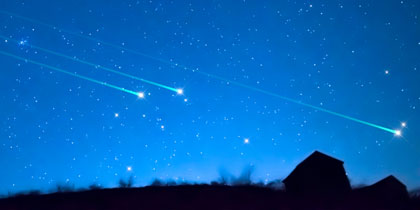
August 9, 2016, by Lindsay Brooke
What has the comet Swift-Tuttle got to do with the Perseid meteor shower?
The Perseid meteor shower is one of the most stunning celestial events in the astronomical calendar and this year it will be better than usual.
Perseids are so called because they appear to come from the constellation Perseus. But, as Christopher Conselice, Professor of Astrophysics explains – the Perseid cloud is actually debris in space which has been shredded from the comet Swift-Tuttle – a comet we won’t get to see for another 109 years. Professor Conselice studies the formation of galaxies but has come a little closer to earth to explain what this week’s astronomical show is all about.
Even after nearly 20 years as an astronomer the Perseid meteor shower in mid-August this is still one of the most spectacular astronomical events I have seen. If you are at all impressed by the majestic nature of the universe you will not want to miss these Perseids which are making their appearance this week with a peak performance on the 11 and 12 August. Beyond their aesthetic display the fact that these even exist gives us a real connection to the entire solar system.
What is a meteor shower?
Many people have some idea that a meteor shower is when material in space falls to the earth. That is essentially what it is, but what these particles are and where they come from isn’t as well known.
The bright streams of light coming from these meteors as they fall to the ground make specular viewing. The meteor showers we see are essentially the burning up of tiny rock that was in interplanetary space and just happened to fall into the earth’s orbit. This occurs when the earth’s orbit intersects of the ‘pockets’ of debris which are in intra-solar system space.
The Perseid meteor shower has been known about for hundreds of years, but was only identified as a specific meteor shower in the early 19th century. The origin of the Perseids, as for all meteor showers, comes from comets.
Swift-Tuttle debris.
In this case, the comet which produces the Perseids is known as Swift-Tuttle, which was discovered in 1862 by two American astronomers. This was long after the Perseids themselves were found, and it took several decades for astronomers to make the connection between the comet and the meteor shower. Swift-Tuttle was last seen in 1992 and will be observable again in 109 years.
It’s fascinating to realise that the meteor streaks we see across the sky once came from this comet. The way this works is that comet Swift-Tuttle has a 133-year orbit in the solar system which takes it 51 times further from the Sun than the earth is, all the way to within about the distance the Earth is from the Sun. This means that this comet originates from the outer solar system in the so-called Oort cloud beyond the orbit of the planet Neptune and then comes into the inner solar system where it interacts with more massive objects and then losses mass.
We are seeing a remnant of the early formation of the Sun and our planets.
While this is happening, the comet interacts with the gravity of the Sun and other planets, and losses material due to gravitational tides. Since a comet is made up of gases and rock, this is left over once the material is striped. The result is that we are left with a stream of material that orbits the sun and in which the orbit of the Earth takes us directly through, thereby producing the spectacular meteor display. So the steaks of light we see from burning debris during a shower is the left over material which originated in the outer parts of our Solar System and we are seeing a remnant of the early formation of the Sun and our planets.
The reason they are call Perseids is that if you take the radiant – that is the line from which these meteors can be traced from their origin – the constellation they appear to originate from is within Perseus. Thus, the best place to see the Perseids is where the constellation can be seen. Luckily this is throughout the night for most places in the northern hemisphere.
Observing the Perseids should be fairly straight-forward. As with any astronomical event at night, the best place to view these Perseids is in a dark location away from any lights, and with an unobstructed view of the sky. You will not want to miss this year’s show as the number of meteors at the peak of activity is 150 per hour, giving over 2 a minute. This is better than previous years so if anyone is interested in seeing a meteor shower this is the year to stay up and watch – if the skies are clear of course.
No comments yet, fill out a comment to be the first

Leave a Reply